HOMES of ancestors and relatives
This section covers homes, houses, farms etc other than where I personally lived. There are several that are relevant here. All in South Africa, but others of note can be found here:
- Scotts in Shetland - SCOTTS IN SHETLAND
- Watsons in Plymouth - WATSON, DINAH
- Crawford in Belfast - CRAWFORD, HUGH BELFAST
You can find more on my own homes under GROWING UP : THE EARLY YEARS, HOME ENVIRONMENT BEACON BAY and HOME IN BEACON BAY
My father designed a house in Stirling for Graham and Elise (before they moved to Durban, then Westville and eventually Rondebosch). He proudly showed me that he had been innovative by setting the house at an angle on the site, so creating more interesting garden spaces. All the others in the street were boringly square on square sites.
Woodlands Farm, Arnoldton
You will see it mentioned under MILLER JOSEPH
When apartheid became to gather momentum, the "homelands" were steered towards independence and here that meant the Republic of Ciskei. A large buffer zone was created west of the main road from East London to Kingwilliam's Town and Bisho. The Bridledrift Dam was also being built. This in turn resulted in farms being bought out and the buildings demolished.
Norma van As notes that “In 1879 Joseph moved from the King Williams Town district to the farm Woodlands, near Arnoldton, in the East London district”. Joseph Miller is our direct ancestor. It was no longer occupied when this all happened and the premises were already becoming derelict when I found it while researching nearby German Settler buildings.... Ida Emily Miller married Angus William Newman on Woodlands in 1882.
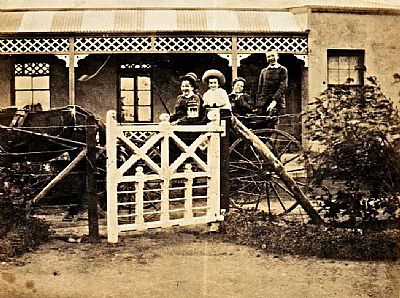
This old photo is simply labelled "Arnoldton". This looks a comfortable and neat cottage. Great horsedrawn transport.
There was a rumour that when the family bought a new cutlery set, they buried the old one in the garden. I wonder if it is still out there somewhere.
St Peter's Road, Southernwood, East London
Granny Maud Watson was widowed early leaving her to raise her 4 strapping sons alone.
I was told stories of them living in a corrugated iron house, quite common at the time, but their was much in need of repairs. The boys would creep outside through a hole in the wall.
This led them to move to a house in St Peter's Road, Southernwood, which I think was owned by their relatives, the Newmans. That has since been demolished to make way for new development, but my father managed to get hold of some of the wooden ballusters. I used them as the railing to the upper level in our new house in the 1980s overlooking the Quinera River in Beacon Bay. (I also managed to get some of the ballusters from Malcomess House nearby when that was demolished and used them as legs for a table I made for the children).

This appears to be St Peter's Road in Southernwood. Some of the houses are large.
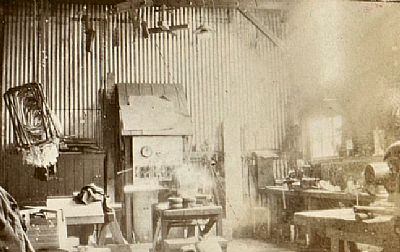
This photo appears on the same page as that above in a disintegrating album. It is a workshop or store. An outbuilding made of corrugated iron. There are what appear to be a heavy lathe, weights, an old wall telephone, work benches and cuboards.
"Put"'s house. More correctly known as Angus Miller Newman
I have listed this separately pending confirmation, but I think this was the same house as that above.
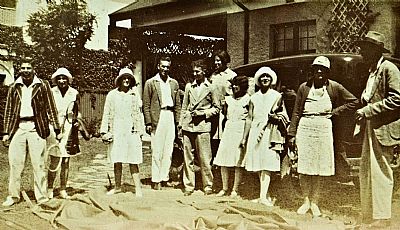
This photo is simply labelled "At Put's Xmas 1930". It shows family and friends about to play tennis. I suspect that the tarpaulin in the foreground has covered the court. Don't you love that tennis gear?
4 Botha Road, Selborne, East London
I found a reference to this address in correspondence between Jack Watson and his brother Brian, my father. He says I do not remember moving to 4 Botha Rd. it must have been done when I was at Boarding School. John apthorp came to stay with me over Easter. We had lots of cars then and Auburn ###, Studebaker, Studebaker etc. I think the value of the house then was £4500. at that time the TRAMS were doing the full circle, & we left our House. Race Course. Blind river, Orient Beach. Town. Home for 1/-. The family had moved about a bit as they could not afford to buy their own home. (### indicates illegible handwriting).
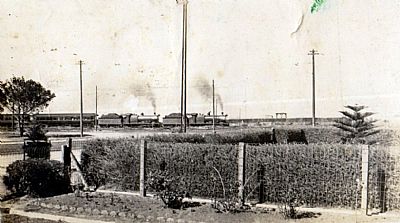
I don't have a picture of the house, but this one is labelled "view from 4 Botha Road". That cross road must be Union Avenue. The railway was much closer that it is now.
Our home where we grew up in our teenage years is not that far from here at 5 Clarendon Road with the back entrance in Nisbet Place. (4 1/2 blocks away). My brother still lives there. We used to play on that railway line, but a little further away with a newer line coming up all the way from the harbour beyond it. The line with the train in the picture is alongside Union Avenue (which accounts for the open band of land between the Avenue and Clarendon School and the sports fields, in recent years having a budget hotel squeezed in too).
4 Seaview Terrace, East London
I do not know who actually owned this house, but many of the photos of the family are of here. It had dramatic views over the sea and was a good place to spot the comings and goings of ship to and from the harbour. Perhaps it was just a great place for them all to meet up.
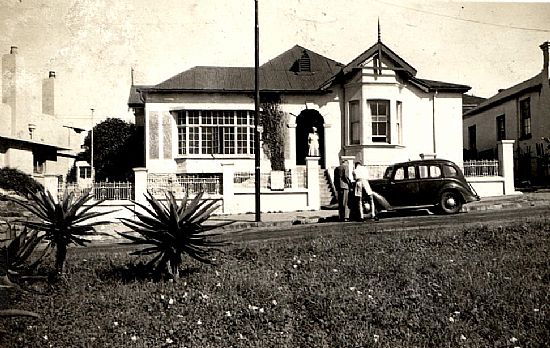
This photo is labelled " 4 Seaview Terrace 1945. Mother, Uncle George Brian & CE 4130 (Hillman Minx 1936 model).
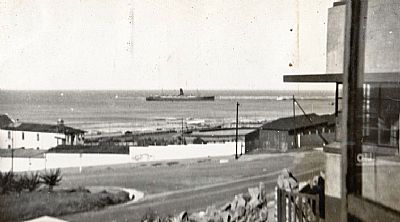
If you look to the left of the family house in the previous photo you will see a modernist neighbouring house. In this picture you can see this a bit intrusive. To the left is the old Beach Hotel.
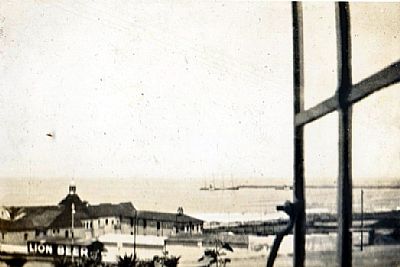
On opening the window and looking only slightly to the left you saw into the Beach Hotel beer garden with the wall advertising Lion Beer. 4 Seaview Terrace was in an ideal position for sea views, but you needed to be a little focussed.
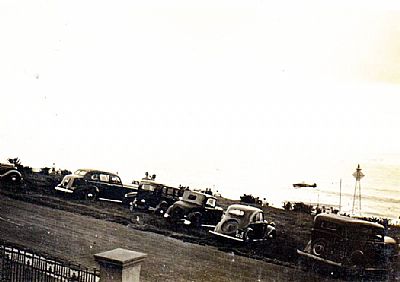
This is a view from the house out to see. The terrace was a really excellent place to view all sorts of things and in this case it is an air display. You can see a military plane passing over the sea well below the house. lots of cars have parked facing outwards to enjoy the spectacle. I saw some air and fireworks displays as a child from roughly the same spot, although by that time the house was no longer in the family. The label notes " Bombing display over sea. Poor show. 2/43. Note ?? ?? & little Austin".
Quenera Cottage
I must point out straight away that this was not a family property, but it was one that they did enjoy. My father would talk of going to "the shack" with fond memories.
Grandpa Alexander's partner built a more substantial building, but "ours" remained very basic.
This was on the east bank of the river opposite the fledgling village of Bonza Bay. It was still relatively wild there even though it was but a stones throw from the latter. Getting there too was an adventure. The road was basic, little more than a farm track, and circuituous. I think the Abbotsford weir road was there, but it was only in the '60s that the main Nahoon Bridge was built.
This subject almost leans to that of BEACHES as A.R. Watson, my great grandfather was in partnership with O'Gorman who built a holiday house on the east bank of the Quinera River mouth. That though was lost when o'Gorman died and the business went under. You can see more on that under BEACHES where I have more photos of the family and friends on the beach or cavorting in the estuary.
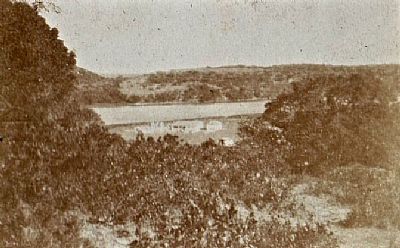
This is a view of the Quenera River mouth with the beach cottages and outbuildings in the foreground. One was a simple shack, the other more substantial. The fledgling village of Bonza Bay is beyond. The beach is to the left.
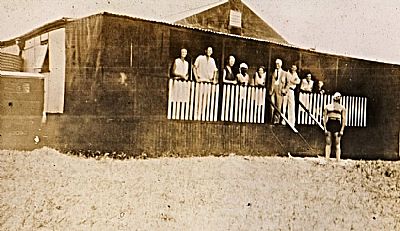
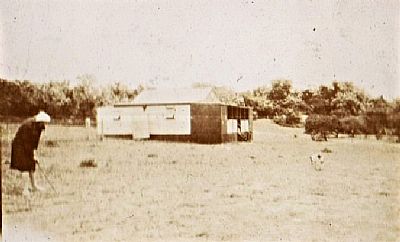
A family member practices her gold swing on the grass in front of the shack. (She appears doing this on the beach too. "Quinera - Xmas 1930". See BEACHES
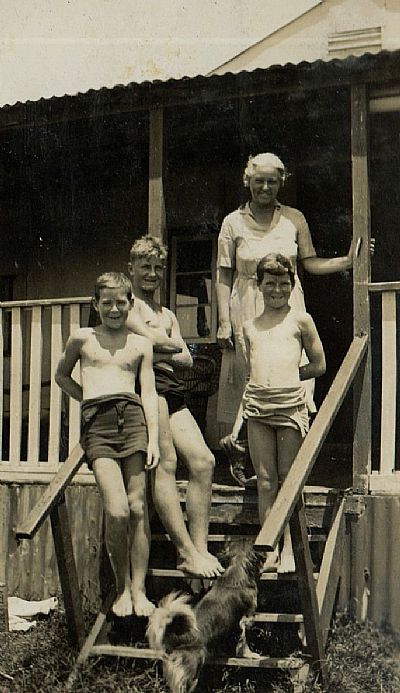
Granny Maud with her son Graham and also friends Hinds and Quentin B-Smith. Boys and men would swim in full torso bathing costumes, but as you see these were quickly peeled down when they were running around the shack.
Compare the "shack" depicted above with that below which is what Grandpa Alexander's partner built. I wonder if the shack was a predecessor of this and allocated to our family to use. It is not evident from the photos that they existed at the same time, but there was enough space for that to be the case. It may be that the "shack" was upgraded. There appears to be something of the same size to one side.
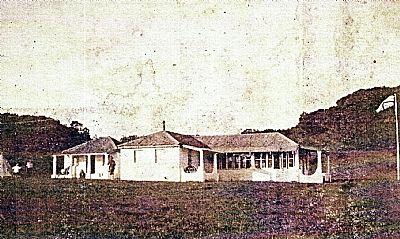
This looks comparatively grand. But there are the same wooded dunes. A bell tent is pitched to one side. A Union Jack flutters from a flagpole. By the time that got to know this site many many years later, there was little open lawn left. The Norfolk Pines shown in a preceding photo were by that time very tall.
Zewenfontein, near Kuilsrivier, Cape
This has been discussed under WATSON JACK MONTAGUE and to WATSON HILDEGARD but deserves some more description here.
They farmed in Rhodesia (now Zimbabwe) before moving to Zevenfontein, a predominantly wine farm near Kuilsrivier in the Cape. I visited on several occasions. The house was built in 1800 and has the date on its Cape Dutch gable.
The walls were impressively thick with the windows low so we could easily climb through them.
I have a fond memory of eating large grapes straight from the vine while riding a horse; of trying to shoot guinea fowl who out-smarted us and of trying to fish in the dam. The dam had been constructed by Jack. Also of interest on the farm were two hand dug tin mines from an earlier era. We explored them a bit, but darkness and sudden drops which were flooded hindered much progress.
There was also some tobacco production on a small scale and I saw the results hanging up to dry in the sheds.
There was a settlement on the farm of Coloured folk, so defined in the language of the day. They were the labour force, the grape pickers and besides their wages expected their "dop" as well. While already heavily criticised, habits die slowly and habits it had created. Alcohol problems were to be expected on a wine farm. While the main crop was sent off to the KWV for processing, a basic wine was produced on the premises for this purpose.
The Dop System (also known as the Tot system), while no longer legal in South Africa continues to have a lasting influence on the lifestyle of many South African people who became dependent on alcohol during its relevance. The Dop System (named after the Afrikaans word for an alcoholic drink) was a system of payment used from the beginning of the 19th century through 2003 in which agricultural workers were paid in alcohol for their services instead of being paid in money. [Blue Crane]
Zevenfontein (seven fountains" or springs) was sold and combined with the neighbouring farm, Onverwacht ("unexpected") when Jack retired. and became Zevenwacht. It became a very upmarket events and accommodation venue.
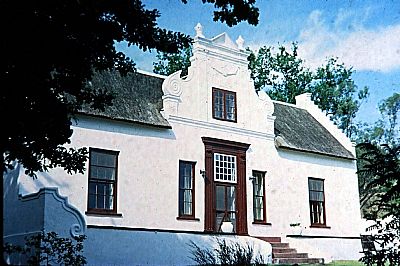

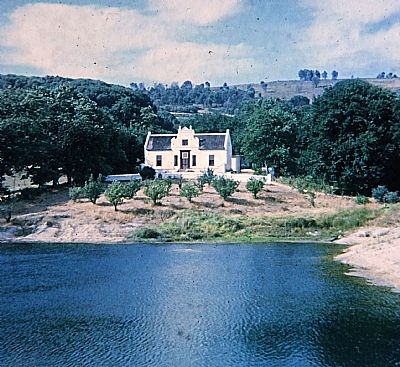
Some views of the house with the dam constructed by Jack. Visitors today will notice some changes to the house. The dam for instance is now more enclosed by vegetation. The original raised emtrance terrace has a railing to best deal with modern usage.
BLUE CRANE IMPORTS : https://www.bluecraneimports.com/the-legacy-of-the-dop-system/
ZEVENWACHT: http://www.zevenwacht.co.za/.

